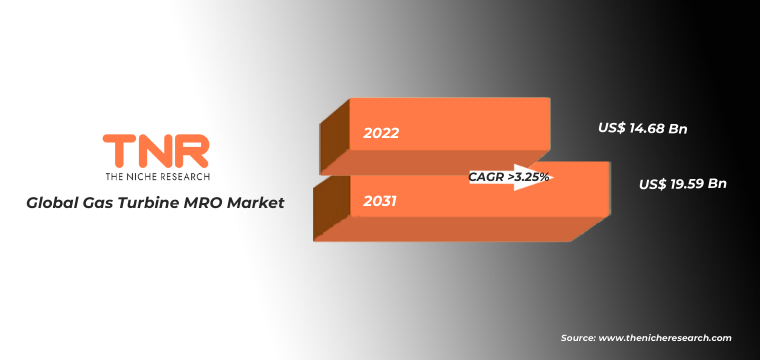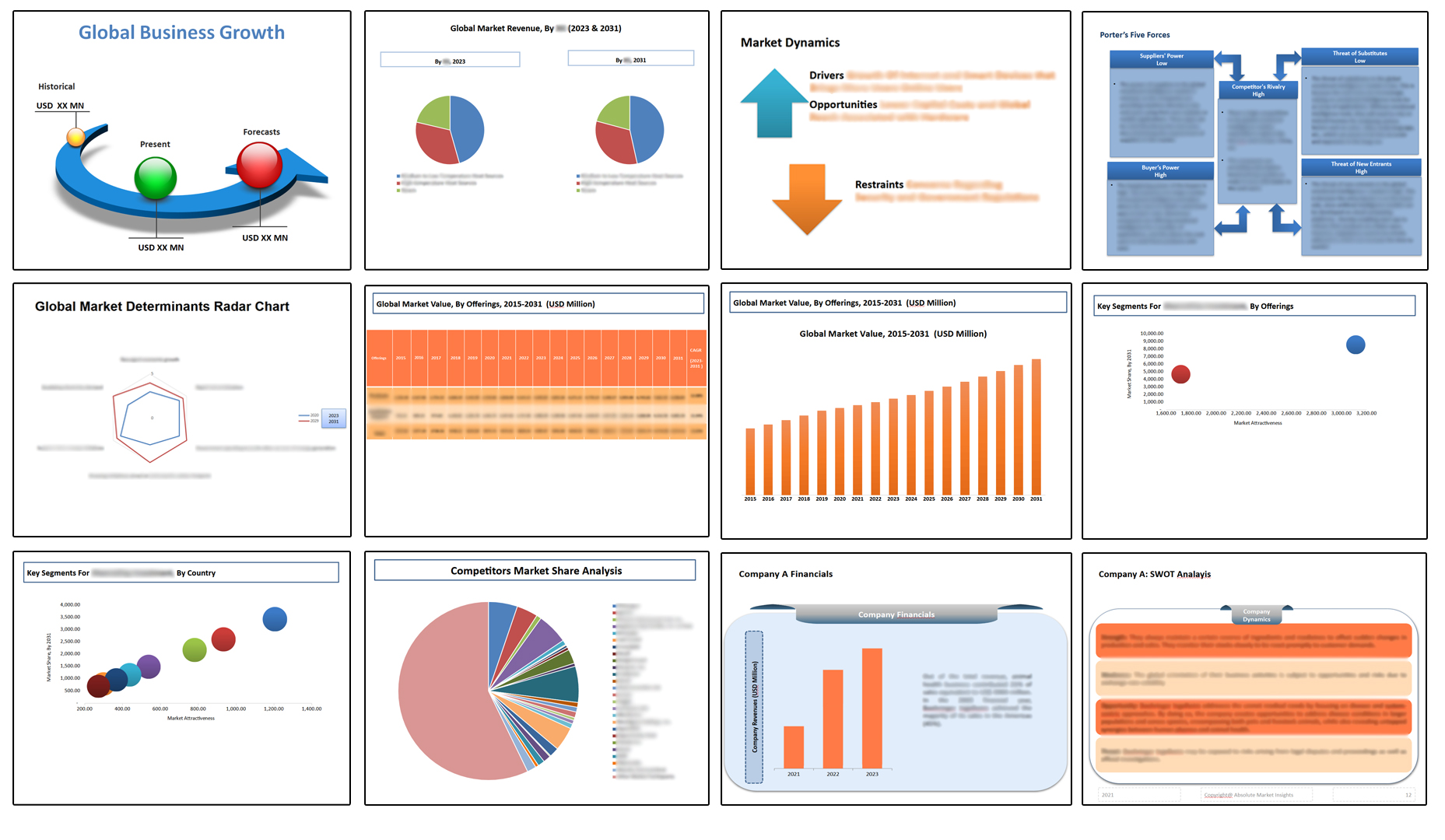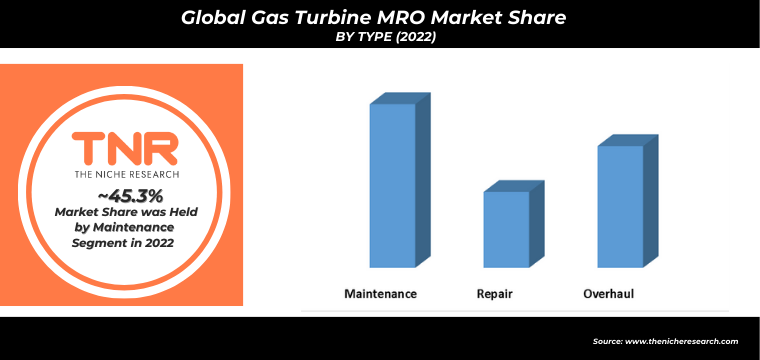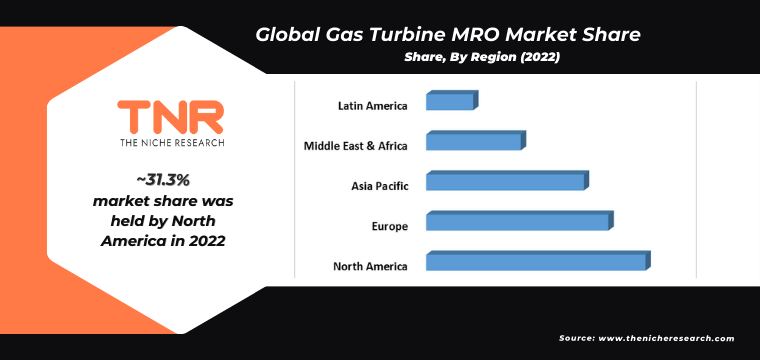Global Gas Turbine MRO Market By Technology, By Type, By Provider Type, By End-Use, By Region: Global Insights, Growth, Size, Comparative Analysis, Trends and Forecast, 2023 – 2031
- Industry: Semiconductors & Electronics
- Report ID: TNR-110-932
- Number of Pages: 420
- Table/Charts : Yes
- November, 2023
- Base Year : 2024
- No. of Companies : 10+
- No. of Countries : 29
- Views : 10297
- Covid Impact Covered: Yes
- War Impact Covered: Yes
- Formats : PDF, Excel, PPT
Global Gas Turbine MRO Market was valued at US$ 14.68 Billion in 2022, growing at an estimated CAGR of 3.2% from 2023-2031.
Gas Turbine MRO (Maintenance, Repair, and Overhaul) encompasses a set of activities aimed at ensuring the reliability and performance of gas turbines used in various applications, including power generation and aviation. It involves inspections, repairs, parts replacement, and regular maintenance to extend the lifespan and efficiency of gas turbines.
The heavy duty technology segment currently dominates the global gas turbine MRO market. This dominance is primarily due to the widespread use of heavy-duty gas turbines in power generation and industrial applications. The study highlights the extensive adoption of heavy-duty gas turbines for their robustness and efficiency in large-scale operations, contributing to their dominant market position.
Global Gas Turbine MRO Market Revenue & Forecast, (US$ Million), 2015 – 2031

COVID-19 Impact Analysis on Global Gas Turbine MRO Market
Before the pandemic, the Gas Turbine MRO Market was steadily growing, driven by the need for maintenance and upgrades in the aging gas turbine fleet. Increasing energy demand and aircraft utilization contributed to a consistent demand for MRO services. The COVID-19 pandemic had a mixed impact on the Gas Turbine MRO Market. While some sectors, such as aviation, saw a temporary decline in MRO demand due to reduced flights, the energy sector continued to require maintenance to ensure reliable power generation. The market’s recovery hinged on economic rebound and resumption of regular industrial and aviation activities.
Report Coverage and Deliverables

One significant driver in the Gas Turbine MRO Market is the aging gas turbine fleet. According to the International Energy Agency, many gas turbines worldwide are nearing the end of their operational lifespan. This aging infrastructure necessitates regular maintenance, repairs, and overhauls to ensure continued reliability and efficiency. A survey by Gas Turbine World indicated that approximately 37% of gas turbines in use are over 20 years old, underscoring the pressing need for MRO services.
The aging fleet serves as a robust driver, propelling the demand for Gas Turbine MRO to keep turbines operational and meet energy demands. A significant restraint in the Gas Turbine MRO Market is economic uncertainty. Market fluctuations, geopolitical tensions, and economic downturns can impact capital expenditure on MRO services. During such periods, industries may delay or scale down maintenance projects to conserve resources. The COVID-19 pandemic, for instance, disrupted aviation MRO as airlines reduced flights. Economic stability is crucial for sustained investment in MRO services. Organizations and governments must navigate economic challenges to ensure consistent demand for Gas Turbine MRO.
 The maintenance segment currently dominates the global gas turbine MRO Market. Regular maintenance activities are critical to ensure the ongoing reliability and efficiency of gas turbines. According to data from the Gas Turbine Users Symposium, maintenance accounts for a substantial share of MRO activities, as it is an ongoing requirement for the safe operation of gas turbines.
The maintenance segment currently dominates the global gas turbine MRO Market. Regular maintenance activities are critical to ensure the ongoing reliability and efficiency of gas turbines. According to data from the Gas Turbine Users Symposium, maintenance accounts for a substantial share of MRO activities, as it is an ongoing requirement for the safe operation of gas turbines.
North America dominated the global gas turbine MRO market in 2022. This dominance is substantiated by a significant number of gas turbines in operation, particularly in power generation and aviation. According to the U.S. Energy Information Administration, North America has a substantial gas turbine capacity. The region’s focus on efficient energy production and air travel contributes to its leadership in the Gas Turbine MRO Market.
 Competitive Landscape
Competitive Landscape
The report provides both, qualitative and quantitative research of global gas turbine MRO market, as well as provides comprehensive insights and development methods adopted by the key contenders. The report also offers extensive research on the key players in this market and details on the competitiveness of these players. Key business strategies such as mergers and acquisitions (M&A), affiliations, collaborations, and contracts adopted by these major market participants are also recognized and analyzed in the report. For each company, the report studies their global presence, competitors, service offerings and specification amongst others.
Some of the players operating in the global Gas Turbine MRO market are
- MITSUBISHI HEAVY INDUSTRIES, LTD.
- Ansaldo Energia
- Baker Hughes Company
- Doosan Enerbility
- General Electric
- Kawasaki Heavy Industries, Ltd.
- Metalock Engineering
- Siemens Energy
- Solar Turbines Incorporated
- Sulzer Ltd
- Other Industry Participants
Report Summary of Global Gas Turbine MRO Market
| Report Specifications | Details |
| Market Revenue in 2022 | US$ 14.68 Billion |
| Market Size Forecast by 2031 | US$ 19.59 Billion |
| Growth Rate (CAGR) | 3.25% |
| Historic Data | 2015 – 2021 |
| Base Year for Estimation | 2022 |
| Forecast Period | 2023 – 2031 |
| Report Inclusions | Market Size & Estimates, Market Dynamics, Competitive Scenario, Trends, Growth Factors, Market Determinants, Key Investment Segmentation, Product/Service/Solutions Benchmarking |
| Segments Covered | By Technology, By Type, By Provider Type, By End-Use |
| Regions Covered | North America, Europe, Asia Pacific, Middle East & Africa, Latin America |
| Countries Covered | U.S., Canada, Mexico, Rest of North America, France, The UK, Spain, Germany, Italy, Nordic Countries (Denmark, Finland, Iceland, Sweden, Norway), Benelux Union (Belgium, The Netherlands, Luxembourg), Rest of Europe, China, Japan, India, New Zealand, Australia, South Korea, Southeast Asia (Indonesia, Thailand, Malaysia, Singapore, Rest of Southeast Asia), Rest of Asia Pacific, Saudi Arabia, UAE, Egypt, Kuwait, South Africa, Rest of Middle East & Africa, Brazil, Argentina, Rest of Latin America |
| Key Players | MITSUBISHI HEAVY INDUSTRIES, LTD., Ansaldo Energia, Baker Hughes Company, Doosan Enerbility, General Electric, Kawasaki Heavy Industries, Ltd., Metalock Engineering, Siemens Energy, Solar Turbines Incorporated, Sulzer Ltd, Other Industry Participants |
| Customization Scope | Customization allows for the inclusion/modification of content pertaining to geographical regions, countries, and specific market segments. |
| Pricing & Procurement Options | Explore purchase options tailored to your specific research requirements |
| Contact Details | Consult With Our Expert
Japan (Toll-Free): +81 663-386-8111 South Korea (Toll-Free): +82-808-703-126 Saudi Arabia (Toll-Free): +966 800-850-1643 United Kingdom: +44 753-710-5080 United States: +1 302-232-5106 E-mail: askanexpert@thenicheresearch.com
|
Global Gas Turbine MRO Market:
By Technology
- Heavy Duty
- Light Industrial
- Aero-Derivative
By Type
- Maintenance
- Repair
- Overhaul
By Provider Type
- OEM
- Independent Service Provider
- In-House
By End-Use
- Power Generation
- Oil and Gas
- Others
By Region
- North America (U.S., Canada, Mexico, Rest of North America)
- Europe (France, The UK, Spain, Germany, Italy, Nordic Countries (Denmark, Finland, Iceland, Sweden, Norway), Benelux Union (Belgium, The Netherlands, Luxembourg), Rest of Europe
- Asia Pacific (China, Japan, India, New Zealand, Australia, South Korea, Southeast Asia (Indonesia, Thailand, Malaysia, Singapore, Rest of Southeast Asia), Rest of Asia Pacific)
- Middle East & Africa (Saudi Arabia, UAE, Egypt, Kuwait, South Africa, Rest of Middle East & Africa)
- Latin America (Brazil, Argentina, Rest of Latin America)
Table of Contents
**Exclusive for Multi-User and Enterprise User.
Global Gas Turbine MRO Market Segmentation
By Technology
By Type
By Provider Type
By End-Use
By Region
**Note: The report covers cross-segmentation analysis by region further into countries
The Niche Research approach encompasses both primary and secondary research methods to provide comprehensive insights. While primary research is the cornerstone of our studies, we also incorporate secondary research sources such as company annual reports, premium industry databases, press releases, industry journals, and white papers.
Within our primary research, we actively engage with various industry stakeholders, conducting paid interviews and surveys. Our meticulous analysis extends to every market participant in major countries, allowing us to thoroughly examine their portfolios, calculate market shares, and segment revenues.
Our data collection primarily focuses on individual countries within our research scope, enabling us to estimate regional market sizes. Typically, we employ a bottom-up approach, meticulously tracking trends in different countries. We analyze growth drivers, constraints, technological innovations, and opportunities for each country, ultimately arriving at regional figures.Our process begins by examining the growth prospects of each country. Building upon these insights, we project growth and trends for the entire region. Finally, we utilize our proprietary model to refine estimations and forecasts.
Our data validation standards are integral to ensuring the reliability and accuracy of our research findings. Here’s a breakdown of our data validation processes and the stakeholders we engage with during our primary research:
- Supply Side Analysis: We initiate a supply side analysis by directly contacting market participants, through telephonic interviews and questionnaires containing both open-ended and close-ended questions. We gather information on their portfolios, segment revenues, developments, and growth strategies.
- Demand Side Analysis: To gain insights into adoption trends and consumer preferences, we reach out to target customers and users (non-vendors). This information forms a vital part of the qualitative analysis section of our reports, covering market dynamics, adoption trends, consumer behavior, spending patterns, and other related aspects.
- Consultant Insights: We tap into the expertise of our partner consultants from around the world to obtain their unique viewpoints and perspectives. Their insights contribute to a well-rounded understanding of the markets under investigation.
- In-House Validation: To ensure data accuracy and reliability, we conduct cross-validation of data points and information through our in-house team of consultants and utilize advanced data modeling tools for thorough verification.
The forecasts we provide are based on a comprehensive assessment of various factors, including:
- Market Trends and Past Performance (Last Five Years): We accurately analyze market trends and performance data from preceding five years to identify historical patterns and understand the market’s evolution.
- Historical Performance and Growth of Market Participants: We assess the historical performance and growth trajectories of key market participants. This analysis provides insights into the competitive landscape and individual company strategies.
- Market Determinants Impact Analysis (Next Eight Years): We conduct a rigorous analysis of the factors that are projected to influence the market over the next eight years. This includes assessing both internal and external determinants that can shape market dynamics.
- Drivers and Challenges for the Forecast Period:Identify the factors expected to drive market growth during the forecast period, as well as the challenges that the industry may face. This analysis aids in deriving an accurate growth rate projection.
- New Acquisitions, Collaborations, or Partnerships: We keep a close watch on any new acquisitions, collaborations, or partnerships within the industry. These developments can have a significant impact on market dynamics and competitiveness.
- Macro and Micro Factors Analysis:A thorough examination of both macro-level factors (e.g., economic trends, regulatory changes) and micro-level factors (e.g., technological advancements, consumer preferences) that may influence the market during the forecast period.
- End-User Sentiment Analysis: To understand the market from the end-user perspective, we conduct sentiment analysis. This involves assessing the sentiment, preferences, and feedback of the end-users, which can provide valuable insights into market trends.
- Perspective of Primary Participants: Insights gathered directly from primary research participants play a crucial role in shaping our forecasts. Their perspectives and experiences provide valuable qualitative data.
- Year-on-Year Growth Trend: We utilize a year-on-year growth trend based on historical market growth and expected future trends. This helps in formulating our growth projections, aligning them with the market’s historical performance.
Research process adopted by TNR involves multiple stages, including data collection, validation, quality checks, and presentation. It’s crucial that the data and information we provide add value to your existing market understanding and expertise. We have also established partnerships with business consulting, research, and survey organizations across regions and globally to collaborate on regional analysis and data validation, ensuring the highest level of accuracy and reliability in our reports.








